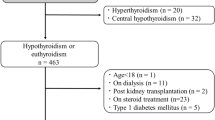Abstract
Purpose
While the effects of hypothyroidism on renal function have been studied extensively, there is less information concerning the effect of hyperthyroidism. We aimed to elucidate the effect of overt and subclinical hyperthyroidism, on estimated glomerular filtration rate (eGFR) with large number of patients treated for hyperthyroidism and after euthyroidism was achieved.
Method
A total of 433 consecutive overt and subclinical hyperthyroid patients were included in the study. We assessed serum fT3, fT4, TSH, BUN, creatinine, and eGFR measurements during both hyperthyroid and euthyroid states of the same patients. The eGFR was calculated using the simplified modification of diet in renal disease (MDRD) Formula.
Results
Among these patients, 367 had overt, and 66 had subclinical hyperthyroidism. fT3, fT4, and eGFR measurements decreased, meanwhile BUN, creatinine and TSH levels increased significantly after euthyroidism was achieved (p < 0.0001 for all). The correlation analyses revealed that eGFR in hyperthyroid state (eGFRh) and fT3 in hyperthyroid state (fT3h) (r = 0,210, p < 0,0001), and fT4 in hyperthyroid state (fT4h) (r = 0,176, p < 0,0001) were significantly correlated. ∆GFR did not differ between overt hyperthyroid group and subclinical hyperthyroid group.
Conclusions
We observed a significant decline in eGFR measurements after the patients became euthyroid. Some of these patients had lower values than 60 mL/min/1.73 m2, which mean that hyperthyroidism may be masking mild renal failure.


Similar content being viewed by others
References
L.H. Mariani, J.S. Berns, The renal manifestations of thyroid disease. J. Am. Soc. Nephrol. 23(1), 22–26 (2012). https://doi.org/10.1681/ASN.2010070766.8.
O. Bulur, K. Dal, D.T. Ertugrul, M. Eser, F. Kaplan Efe, S. Karakaya et al. Renal function improves with the treatment of hypothyroidism. Endocr. Res. 42(3), 246–251 (2017). https://doi.org/10.1080/07435800.2017.1293686.
P. Iglesias, M.A. Bajo, R. Selgas, J.J. Diez, Thyroid dysfunction and kidney disease: an update. Rev. Endocr. Metab. Disord. 18(1), 131–144 (2017). https://doi.org/10.1007/s11154-016-9395-7.
J.G. den Hollander, R.W. Wulkan, M.J. Mantel, A. Berghout, Correlation between severity of thyroid dysfunction and renal function. Clin. Endocrinol. 62(4), 423–427 (2005). https://doi.org/10.1111/j.1365-2265.2005.02236.x.
M. Kimmel, N. Braun, M.D. Alscher, Influence of thyroid function on different kidney function tests. Kidney Blood Press Res. 35(1), 9–17 (2012). https://doi.org/10.1159/000329354.
J.D. Kopple, National kidney foundation K/DOQI clinical practice guidelines for nutrition in chronic renal failure. Am. J. Kidney Dis. 37(1Suppl 2), S66–S70 (2001).
M.T. Sun, F.C. Hsiao, S.C. Su, D. Pei, Y.J. Hung, Thyrotropin as an independent factor of renal function and chronic kidney disease in normoglycemic euthyroid adults. Endocr. Res. 37(3), 110–116 (2012). https://doi.org/10.3109/07435800.2011.640374.
W. Wang, C. Li, S.N. Summer, S. Falk, R.W. Schrier, Polyuria of thyrotoxicosis: downregulation of aquaporin water channels and increased solute excretion. Kidney Int. 72(9), 1088–1094 (2007). https://doi.org/10.1038/sj.ki.5002475. 17700641.
T. Shirota, T. Shinoda, T. Yamada, T. Aizawa, Alteration of renal function in hyperthyroidism: increased tubular secretion of creatinine and decreased distal tubule delivery of chloride. Metabolism 41(4), 402–405 (1992).
D.T. Ertugrul, B. Yavuz, N. Ata, A.A. Yalcin, M. Kucukazman, B. Algul et al. Decreasing brain natriuretic peptide levels after treatment for hyperthyroidism. Endocr. J. 56(9), 1043–1048 (2009).
H. Takase, Y. Dohi, Kidney function crucially affects B-type natriuretic peptide (BNP), N-terminal proBNP and their relationship. Eur. J. Clin. Invest. 44(3), 303–308 (2014). https://doi.org/10.1111/eci.12234.
Author information
Authors and Affiliations
Corresponding author
Ethics declarations
Conflict of interest
The authors declare that they have no conflict of interest.
Ethical approval
All procedures performed in studies involving human participants were in accordance with the ethical standards of the institutional and/or national research committee and with the 1964 Helsinki declaration and its later amendments or comparable ethical standards. The study was approved by Kecioren Teaching and Research Hospital Clinical Research Ethics Committee (number: 1515).
Additional information
Publisher’s note: Springer Nature remains neutral with regard to jurisdictional claims in published maps and institutional affiliations.
Rights and permissions
About this article
Cite this article
Sönmez, E., Bulur, O., Ertugrul, D.T. et al. Hyperthyroidism influences renal function. Endocrine 65, 144–148 (2019). https://doi.org/10.1007/s12020-019-01903-2
Received:
Accepted:
Published:
Issue Date:
DOI: https://doi.org/10.1007/s12020-019-01903-2




